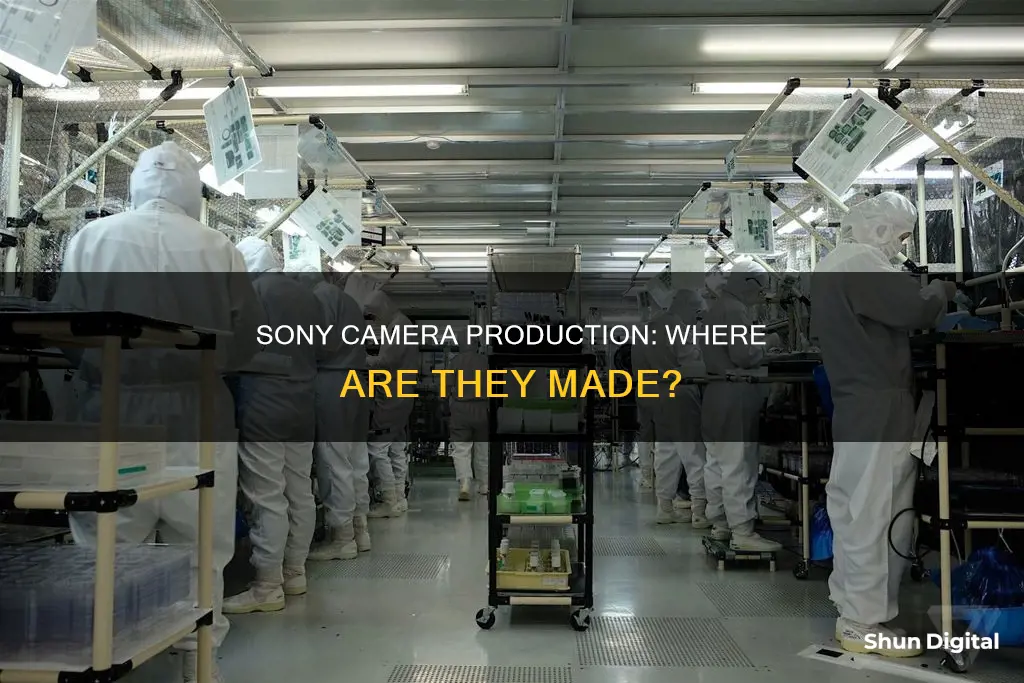
Sony has moved most of its camera production from China to Thailand. Cameras sold in Japan, the US, and Europe will now be produced in Thailand, while cameras sold in China will continue to be produced there. This move is part of a broader trend of tech companies reducing their dependence on China for manufacturing. Sony's decision was influenced by political tensions between China and other nations and the need to diversify its supply chain due to China's Zero COVID policy, which caused frequent lockdowns and supply chain disruptions.
| Characteristics | Values |
|---|---|
| Percentage of camera production moved out of China | 90% to 92% |
| Locations of camera production | Thailand, China |
| Markets served by cameras produced in Thailand | Japan, the US, and Europe |
| Markets served by cameras produced in China | China |
| Reason for moving production out of China | Political pressure, supply chain diversification, lockdowns due to "Zero COVID" policy |
| Percentage of production kept for quality control | 10% for cameras, 5% for lenses |
| Country of origin for camera sensors | Japan |
What You'll Learn

Sony has moved 90% of its camera production from China to Thailand
The decision was made due to the risk of wholly China-based manufacturing to its supply chain. Sony determined that the increasing tensions with the United States and the regular lockdowns that have resulted from the country's "no COVID" policy have disrupted the supply chain too much to be ignored.
The transition has been in progress for a couple of years, with Sony first moving manufacturing to support the US market, then adding Japan and European supplies out of China at the end of 2022. While the goal is to keep production for China in China and all other markets in Thailand, Sony will maintain equipment that can be used for sales outside of China if unforeseen circumstances in Thailand cause disruptions.
Sony is not the only company to move manufacturing out of China, with Canon and Apple also relocating some of their production to other countries. Nikon also manufactures principally in Thailand.
Sony sold about 2.11 million cameras worldwide in 2022, with 150,000 of those sold in China and the remainder going elsewhere.
Where to Find Adobe Camera Raw
You may want to see also

Cameras for Japan, the US, and Europe will be made in Thailand
Sony has shifted its camera production for the Japan, US, and European markets to Thailand, moving away from China. This move is part of a broader strategy to safeguard supply chains by reducing dependence on China. The decision comes after disruptions to the supply chain caused by China's "no-COVID" policy and increasing tensions with the United States.
Sony's camera production for these markets will now primarily take place in Thailand, with the company's plant in China focusing on the domestic market. This transition has been in the works for a couple of years, and by the end of 2022, Sony had fully transferred production for Japan, the US, and Europe to Thailand.
The Thailand factory has been operational for a few years, and Sony even allowed a select few to tour the facility and see the handmade craftsmanship that goes into their high-tech cameras. The move to Thailand is expected to bring about a more stable supply chain for Sony, as the company works to address the issue of heavy reliance on Chinese production.
While Sony is moving production for these markets out of China, the company has affirmed its commitment to the Chinese market and intends to continue producing products like TVs, game consoles, and camera lenses in China, which will be exported to other countries.
The Power of Wyze Cameras: Battery or Plug-in?
You may want to see also

Sony's plant in China will produce cameras for the domestic market
Sony has moved most of its camera manufacturing for markets outside of China to Thailand. The company has deemed the risk of wholly China-based manufacturing to its supply chain too high. This is due to increasing tensions with the United States and the country's "no COVID" policy, which has resulted in lockdowns that have disrupted the supply chain.
Sony's plant in China will now principally produce cameras for the domestic market. The company will retain some production facilities in China to be brought back online in emergencies.
In 2022, Sony sold about 2.11 million cameras worldwide. Of these, 150,000 units were destined for China, with more than 90% being sold in Japan, the United States, and Europe. Most of the production for these markets has now been transferred to Thailand.
For camera lenses, Sony plans to continue supplying products made in China to other countries.
Charging Your Lumix Camera Battery: No Charger Required
You may want to see also

Sony's Thailand factory employs mostly women
Sony has moved most of its camera production from China to Thailand, with 90% of its cameras sold in Japan, the US, and Europe now produced in the latter country. The company has deemed the risk of wholly China-based manufacturing to its supply chain too high, especially with the increasing tensions with the US and the country's "no COVID" policy, which has resulted in multiple lockdowns that have disrupted the supply chain.
Sony's Thailand factory is located in the Chonburi area, approximately 60-90 minutes drive outside of Bangkok. The factory grounds are quite park-like, and the temperature in early March can be as high as 91°F, with 70-80% humidity. The factory tour reveals that Sony's camera production process is highly intricate and involves many steps, from subassembly production to quality control checks and functional tests.
Interestingly, Sony's Thailand factory employs mostly women, who are considered more dexterous than men. This is particularly important given the handmade nature of the camera production process. The work requires a high level of concentration and precision, with workers assembling circuit boards, connecting flex-connectors, and conducting initial functional tests. The production line is well-organized, with all parts and tools within arm's reach, ensuring a smooth and efficient workflow.
The factory also includes a lens assembly area, where all of Sony's FE-mount lenses are produced. This area is off-limits to photography, but it involves similar intricate processes as the camera assembly line. Overall, Sony's Thailand factory plays a crucial role in the company's global supply chain, and the dedication and skill of its mostly female workforce contribute to the high-quality cameras that Sony is known for.
Charging Your Canon Powershot SX40: A Quick Guide
You may want to see also

Sony's sensors are made in Japan
Sony has transitioned its camera manufacturing for the Japanese, US, and European markets from China to Thailand, with 90% of its total production now based in the latter country. Cameras made in China will be principally for sale in China. This transition has been underway for a couple of years, with Sony citing supply chain issues and China's "no COVID" policy as reasons for the move.
While Sony is secretive about its factories, it allowed a journalist from Digital Photo Pro magazine to tour its Thailand factory a few years ago. Sony also has a sensor-fabrication plant in Japan, which was damaged by a devastating earthquake.
Sony manufactures its own sensors in Japan, although it has outsourced some production work to Fujitsu. Sony's sensors are used by many other camera brands, including Nikon, Olympus, Pentax, Leica, and Hasselblad.
USB Camera Chargers: What's the Deal?
You may want to see also
Frequently asked questions
Sony has moved 90% of its camera production from China to Thailand. Cameras sold in Japan, the US, and Europe will be produced in Thailand, while cameras sold in China will be manufactured there.
Sony made the decision to move its camera production for two main reasons: political pressure and the need to diversify its supply chain following the disruption caused by China's "Zero COVID" policy, which resulted in multiple lockdowns and supply chain shortages.
Yes, in addition to the political and supply chain factors, Sony also wanted to reduce its dependence on China to mitigate the risk of supply chain disruptions. Thailand has been a manufacturing hub for cameras and lenses for Nikon, Sony, and Canon even before the trade war with China.







